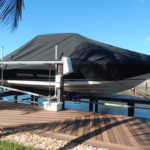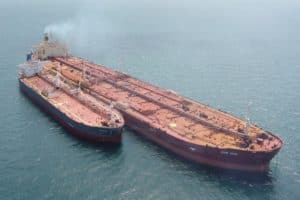A boat lift is a handy tool for cleaning, repairing, painting, or transferring your boat. It is also helpful for keeping your boat out of the water for long periods of time – keeping it dry to prevent water damage. To use a boat lift, you need to determine the boat lift’s capacity.
So this leads us to ask the question: how to determine boat lift capacity? To determine your boat lift capacity, you need to add up the wet weight, dry weight, fuel, gear, and any other additions to your boat. You can find the dry weight of your boat in the brochure or record that came with the boat.
If you don’t have a record of the boat capacity for your boat, you can determine boat lift capacity on the NADA website (National Automobile Dealers Association).
Read on to learn more about how to determine boat lift capacity for your boat or a boat you are planning to buy.
How to Determine Boat Lift Capacity
Unless you have a massive scale lying around that you can put your boat on, you’ll need to use another strategy to weigh your boat. So how to determine boat lift capacity? You need to add in the wet weight, dry weight, fuel, gear, and other inclusions.
Here’s how you can determine the overall weight of your yacht, sailboat, pontoon boat, or other marine boats to get the right boat lift capacity:
1. The brochure or specification sheet included when you purchased your boat will state the boat’s dry weight. The NADA website can be a good guide if the dry weight info is not available in the specification sheet.
2. The type, temperature, and blend of the fuel you’re using for your boat will help determine the weight of the gasoline. According to experts, however, a good estimate is around 0.72 kilograms/liter or 6 pounds/gallon. Multiplying the fuel weight to the full tank capacity of the boat determines the gasoline weight.
3. Water weight is the next thing you need to find out. It works just like the gasoline weight. A good estimate for water is around 0.96 kilograms/liter or 8 pounds/gallon. This figure should be multiplied with the boat’s freshwater tanks, waste, and all livewells’ total capacity to determine an accurate water weight.
4. The dry weight additions are the next item to be added to the equation. Additions include bimini tops, air conditioning units, wakeboard towers, generators, swim platforms, additional seating, and coolers.
5. Everything that is stored in the boat should also be added to its overall weight. This includes scuba equipment, skis, wakeboards, etc.
6. Adding all these will give you the boat’s overall weight. Add a margin of 20 percent and choose the boat weight capacity that has the next higher figure you’ve come up with.
7. One way to avoid getting a boat lift that is too small or too big is to measure the cradle beam length of your boat. It is recommended to add a 12-inch or four-inch cushion on both sides after you’ve measured the width of the beam of the boat. The addition of the cushions depends on whether you need to use the guideposts or dock pile bumpers. Another thing to consider when measuring the cradle beam is to add one diameter between the piles’ center.
8. Another thing you need to determine before you purchase a boat lift is the condition of the water you plan to dock your boat in. Low tide water depth is the most important factor that can help you determine the right boat lift capacity equipment to go for.
Why do you need a margin of safety when determining boat lift capacity?
You may not know it, but multiple adverse factors can impact the lifting capacity of the boat lift. Let’s assume, for instance, that the boat’s central gravity is perfectly centered on the cradles. Yet, parking too far behind or forward the centerline can add unnecessary stress to one side of the lift. Closely placing the bunks to the side of the docks is also another way to add stress to the lift.
Other worst-case scenarios include heavy snowfall weight on the top of the boat or a malfunctioning bilge pump resulting in water accumulation. Forgetting to remove the drain plug during a heavy downpour also will put stress on the lift.
All these reasons are why you need a margin of safety when you purchase a boat lift. All the above unfortunate situations can be avoided by using the right boat lift capacity.
Why You Should Have a Boat Lift
All types of marine vessels need to be elevated to dry land for repairs, maintenance, or stored away. Extreme weather conditions can bring fluctuation of water levels. This condition can cause damage to the boat.
The boat’s exterior may also deteriorate when too much moisture is absorbed. A boat lift is a crucial piece of equipment to make all of these tasks to protect the boat. With the help of a boat lift, getting the boat in and out of the water for whatever purpose becomes quick, easy, and convenient.
Available Boat Lift Capacities
The capacity of different types of boat lifts ranges from 1,500lbs to 250,000lbs. Determining your boat’s wet and dry weight includes factoring in the engines, fuel, batteries, water, and other additions. These are the factors you need to know to make you choose the right boat lift capacity for your boat.
The Types of Boat Lifts to Consider
There are three models of boat lifts to choose from:
- FLOATING provides the best choice for deep-water fixed docks and floating docks.
- BOTTOM STANDING work best for shallow water and fixed docks.
- SUSPENDED should be the top choice for moderately deep water and fixed docks.
Conclusion – How to Determine Boat Lift Capacity?
So how to determine boat lift capacity? To determine the boat lift capacity and size you will require, you need to add up the wet weight, dry weight, fuel, gear, and other inclusions of your boat.
The shopping process when it comes to boat lifts is easy. The hard part is in knowing the right boat lift for your dream boat. While taking time and effort to measure and weigh the boat to determine the perfect boat lift can be a pain, it is the ONLY smartest and cost-effective way to go about it.
Determining the right boat capacity for your boat is crucial if you want a boat in tip-top condition all the time and every time you want to escape to the open water.
It goes without saying that expensive boating accidents can be prevented when the equipment used is right on the mark.
Related reading:






![Boat Floor Replacement Plywood [Best Options] boat floor replacement plywood](https://boatinggeeks.com/wp-content/uploads/2021/07/boat-floor-replacement-plywood-150x150.jpg)
![Read more about the article Boat Floor Replacement Plywood [Best Options]](https://boatinggeeks.com/wp-content/uploads/2021/07/boat-floor-replacement-plywood-300x200.jpg)

